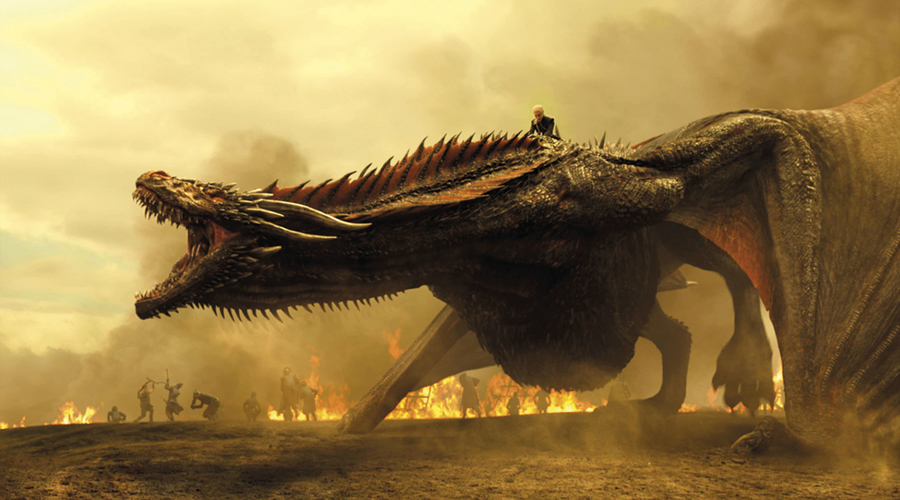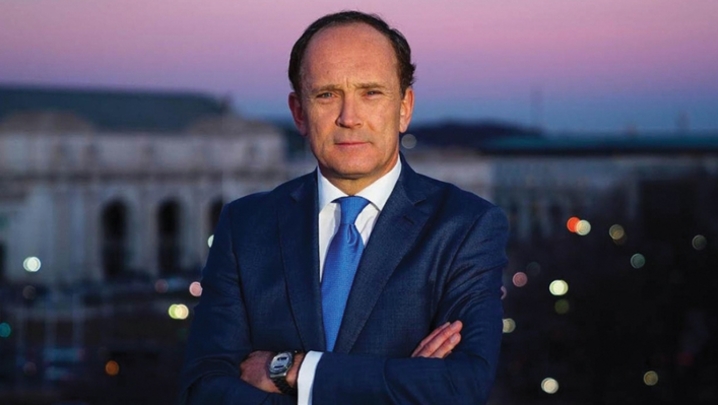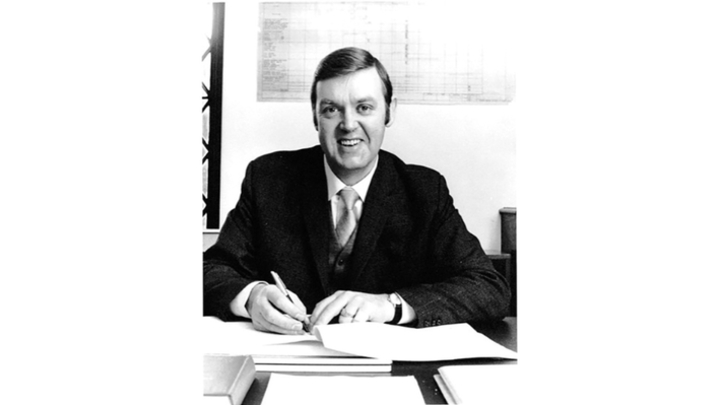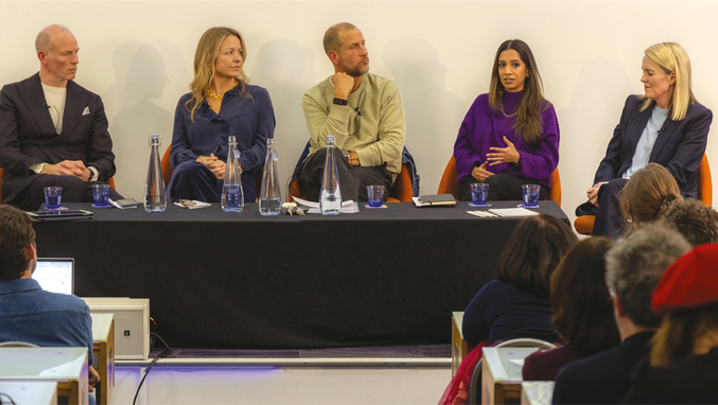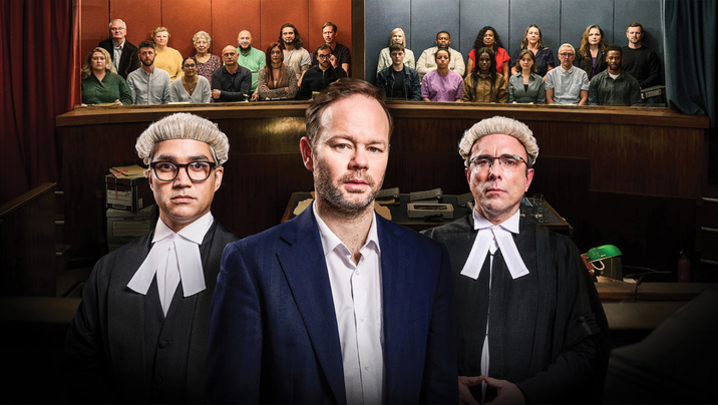Game of Thrones production designer Deborah Riley tells the RTS where she found inspiration for the blockbuster’s style. Steve Clarke reports
She’d worked on an Oscar-winning movie, attended the same stage school as Cate Blanchett and Mel Gibson, and, aged 26, was responsible for art directing the Sydney Olympics closing ceremony. But not even the precociously talented Deborah Riley was prepared for her first day on set in blustery Northern Ireland as the new production designer of Game of Thrones.
“I was absolutely petrified,” she recalled at a sold-out RTS event in Belfast, entitled “Creating the visual world of Game of Thrones”. The illustrated talk by this erstwhile Australian architecture student highlighted some of the visual wonders of Westeros she had helped fashion for TV’s first global scripted blockbuster.
That initial experience of Game of Thrones’s Northern Irish locations – “some of the most beautiful I’ve ever seen” – took place five years ago. It included her first look at Castle Black (HQ of the Night’s Watch) “built on the windiest quarry imaginable. All the timbers are real, the forge is a working forge. I thought: ‘These people are mad.’” Cue laughter from the enthusiastic RTS crowd.
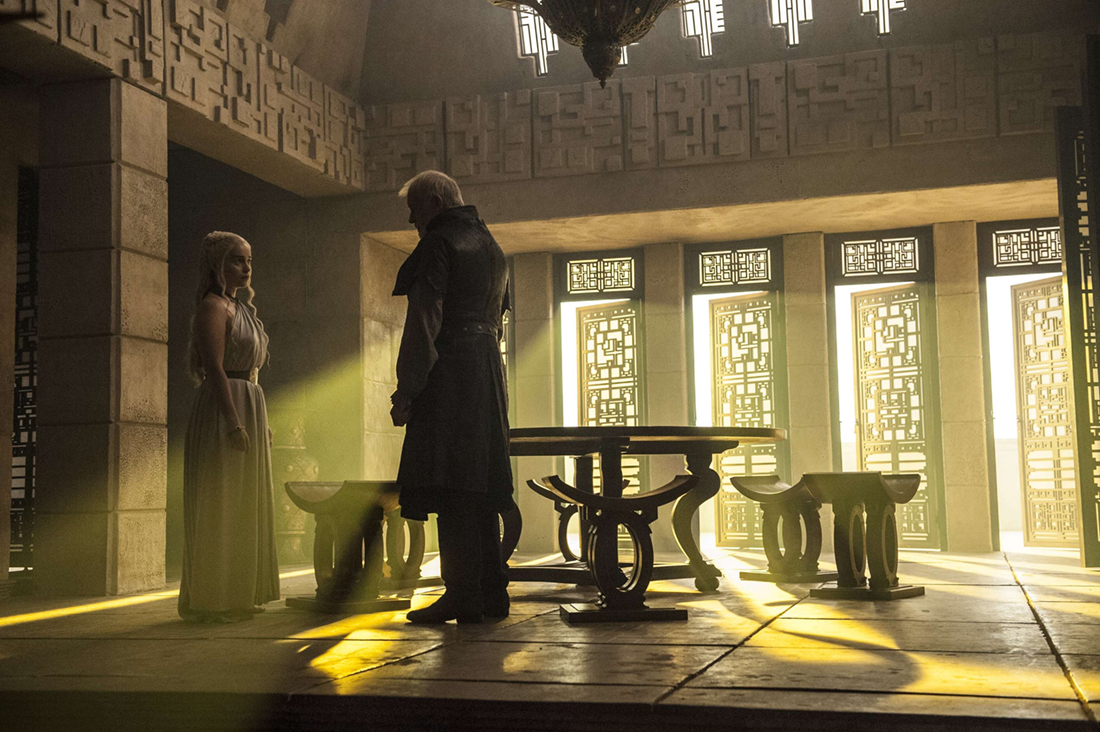
Audience Chamber (Credit: HBO)
Four seasons of Game of Thrones later, Riley’s award-winning designs (see below) are integral to the phenomenal success of the show, which bows out in 2019 at the end of season 8.
“The universe of Game of Thrones includes many different kingdoms. It’s the job of the art department to make sure that those kingdoms are separate and different from one another,” Riley explained. “When that works, the audience accepts these different worlds as being real. In my head, Westeros is about as real as anywhere else.”
Stressing the importance of loyalty, the production designer said: “We’d never have been able to get through the volume of work without all of us returning, year after year.”
She explained that Game of Thrones (despite its reported budget of $10m an episode) involves a fast shooting schedule, unthinkable in the movie sector, where her credits include The Matrix and Moulin Rouge. “During the interview process [for the job] I had to admit to David Benioff [Game of Thrones executive producer and co-creator] that I’d never worked in television before. He replied, ‘But this isn’t television.’”
“We move very, very quickly, which can be frustrating. But the great advantage of that is we can’t muck around. Decisions have to be made, we commit to an idea and get on with it”
Nevertheless, when three different production units can, in theory, be filming simultaneously in three separate counties, the ability to work at speed is essential. Croatia, Iceland and Spain are all used as locations to complement the Irish scenery of the Causeway Coast, Cushendun Caves, Murlough Bay, Ballycastle, Castle Ward, the ruins of Inch Abbey and the surfing beach of Downhill Strand.
“We move very, very quickly, which can be frustrating. But the great advantage of that is we can’t muck around. Decisions have to be made, we commit to an idea and get on with it,” she said.
Having initially studied architecture at the University of Queensland in Brisbane, she abandoned the idea of a career as an architect. (“As my grandmother said, ‘You’re drawing too many straight lines.’”) Instead, she enrolled on a stage design course at Sydney’s famed National Institute of Dramatic Arts – “It accepts eight people a year and I was one of them.”
However, as was clear from her talk, Riley’s passion for buildings and her ability to remember their details has inspired several set designs in Game of Thrones. For the Iron Bank of Braavos, Nazi architect Albert Speer’s designs for Hitler were the starting point: “They are all about power, intimidation and wealth.”
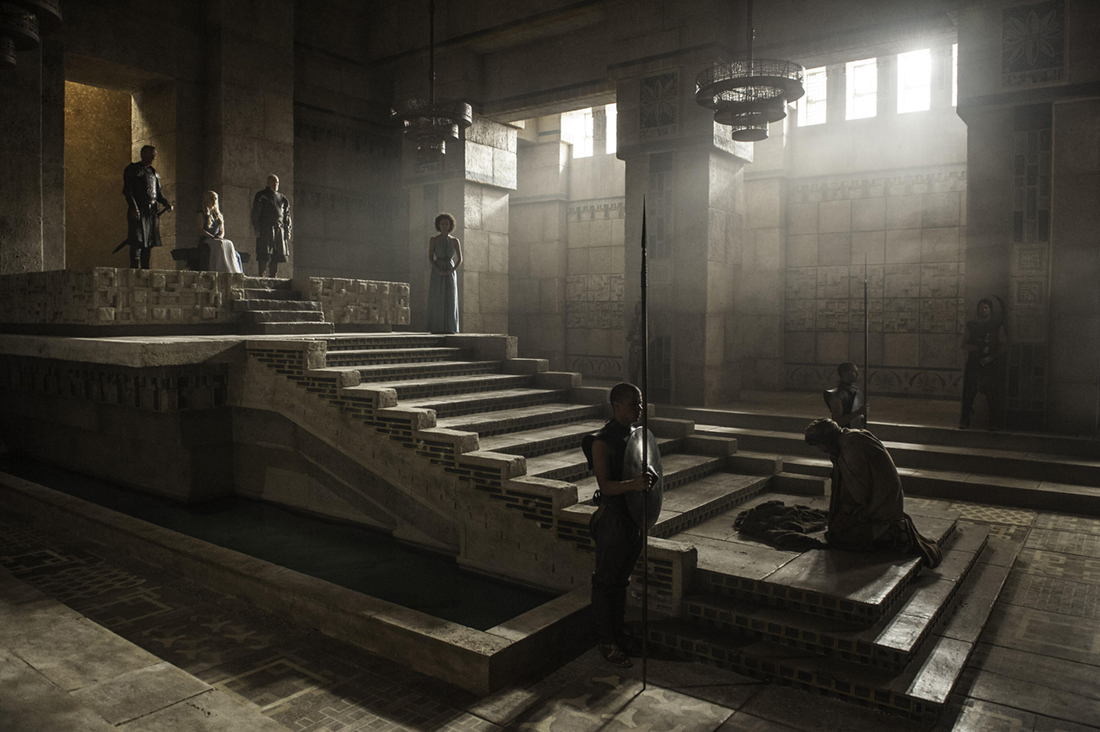
Frank Lloyd Wright was the inspiration for the Meereen Audience Chamber: “I was always very proud of the amount of colour, pattern and texture that we managed to put into that space.” For the House of Black and White, she thought hard about the religious buildings on the banks of the Ganges at Varanasi (“I love the way the stone steps rise up out of the water”), and Hong Kong’s Ten Thousand Buddhas Monastery, which she had visited many years earlier.
Riley revealed how she had been hugely influenced by the “behaviour and environment studies” part of her architecture course – “essentially, the psychology of space” – something that she uses every day at work.
“Whenever we in the art department read any scene, we have to try and figure out how it would work,” she elaborated, “and how we can harness the subtle cues of visual storytelling to better tell the story.”
Her job begins when the art department receives an outline of the upcoming series, written by Benioff and the show’s co-creator, DB Weiss. “These are an absolute joy to read,” she said. “It’s here that the season’s creative ambitions are laid on the table.”
She then decides, in collaboration with the producers, which scenes require location filming and which can be shot on one of the stages at Belfast’s Titanic Studios, the three-hectare site where she is based.
Things do not always go to plan, though. For the climactic battle in “Hardhome”, the eighth episode of season 5, Riley flew to Iceland believing “there might be the perfect location waiting for us”. She saw lava formations on an Icelandic beach that seemed ideal, and a fishing village was built – but, then, “logistics won out and we ended up bringing the entire sequence back to Belfast”.
The logistics of making Game of Thrones could be challenging, she said – until season 6, she worked simultaneously with five different directing teams.
Sets are not always made from scratch, and thinking laterally helps. For instance, “The Mountain and the Viper” episode from series 4 was filmed in Dubrovnik, at a hotel abandoned in the early 1990s, during the Croatian civil war. “It was completely covered in graffiti,” she recalled, “but, for us, the most important thing was that the bones of the amphitheatre were there. After weeks of plaster, paint and rings it was completely transformed.”
To film scenes in a frozen lake, you’d be forgiven for thinking the sequences should be shot in Iceland. Not so, explained Riley: “Due to the amount of stunt work and visual effects, the sequence was brought back to Belfast.
"It was satisfying to think that we were able to capture images like this in camera, and that visual effects weren’t required."
“We filmed in an abandoned quarry near Belfast, painted with a layer of snow to make it look convincing.”
Picasso’s masterpiece Guernica, painted in response to the terror bombing of civilians in the Basque town during the Spanish civil war, was the “perfect reference” for her design for the “Battle of the Bastards” (episode 9 of season 6), because it provided “an appropriate depiction of brutality and darkness”, she said. “The main thing that the art department needed to provide was the body pile.”
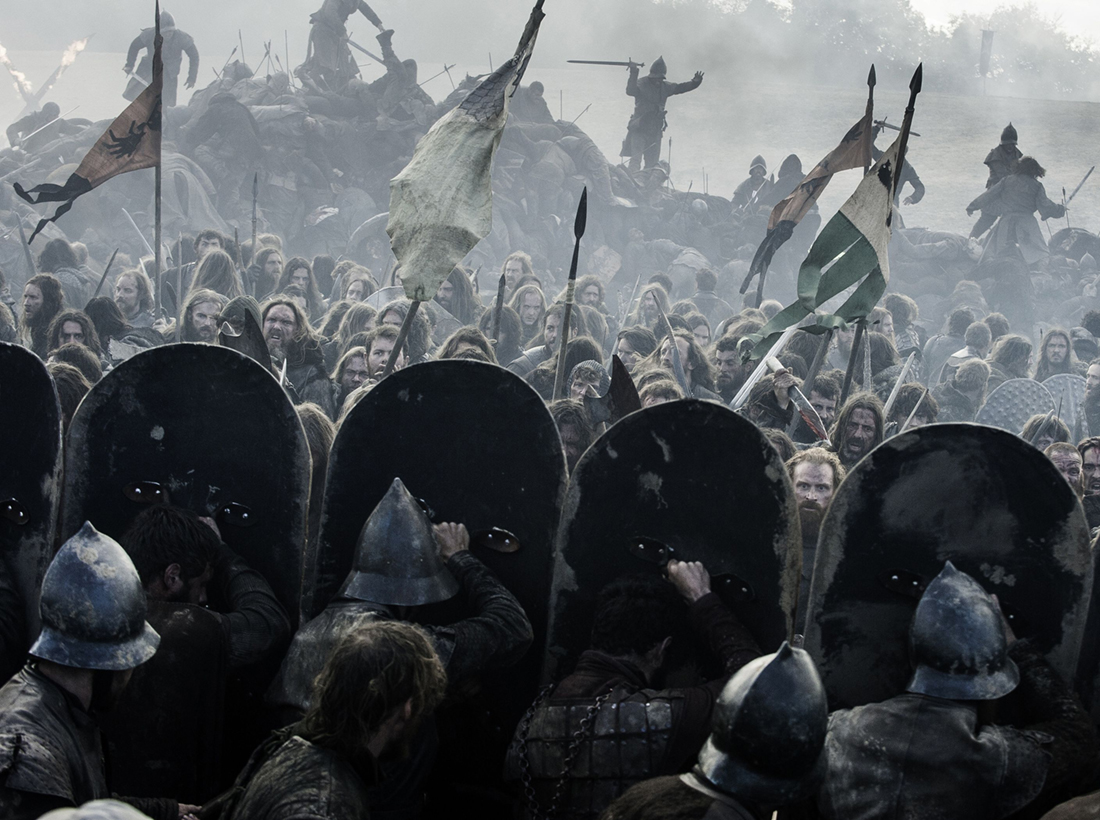
in Game of Thrones (Credit HBO)
Even with Game of Thrones budgets, assembling such an ambitious set required careful thought. “The props department had a variety of dead horses. We had to estimate how many we would need because, at £3,000 a pop for a dead horse, we had to improvise.
“To achieve the body piles, we had to bulk it out with rostrum to make it as efficiently as possible. We also had to provide all the uniforms and saddlery for the battlefield, a massive and thankless task.
“But it was satisfying to think that we were able to capture images like this in camera, and that visual effects weren’t required.”
You sense that Deborah Riley – who, at 45, is certain to go on to work on many more high-profile TV and film projects – has found working on the HBO series hugely satisfying.
“The experience of Game of Thrones, particularly in the lead-up to the end, leaves me absolutely speechless,” she said. “Creatively, it’s been full of the highest highs and the greatest riches that you can possibly imagine. It’s also kicked me to the ground a couple of times, as well.”
‘Creating the visual world of Game of Thrones with production designer Deborah Riley’ was an RTS Northern Ireland event held on 22 May at Black Box, Belfast. Hugh Odling-Smee (Film Hub NI) hosted the Q&A. The producers were Sarah McCaffrey and Sara Gunn-Smith.
Working with the top brass
Deborah Riley: ‘On Game of Thrones… there are a lot of cooks in the kitchen. That’s something that I wasn’t fully prepared for when I arrived.
‘On most features, you’ll have a DoP and a director, and you might have a producer who lays in from time to time. But on Game of Thrones – this sounds terrible – the director is a gun for hire. It is the producers who hold the power and make the creative decisions.
‘There’s a very clear balance between the producers, who have the overarching vision for the show and, at the same time, assign the director for every episode, because they know exactly what imagery they are creating, moment to moment. There’s a surprising amount of politics involved in that.
‘[What I] do is bring them reference. We always see what they respond to and what they’re interested in.
‘The wonderful thing about Game of Thrones is that we’re working with very bright people. They know all the cultural references. They can quote all the movies or the architecture or whatever. We have a language that gets us into the piece immediately.’
Deborah Riley’s trophy cabinet
For Game of Thrones:
Emmy for Outstanding Production Design for a Narrative Contemporary or Fantasy Program (One Hour or More), 2014, 2015 and 2016
Bafta Craft Award – Best Production Design, 2018
Art Directors Guild Excellence in Production Design Awards in Television – One-Hour Period or Fantasy Single-Camera Television Series, 2015, 2016 and 2018
For Moulin Rouge:
Art Directors Guild Excellence in Production Design Awards – Period or Fantasy Film, 2002
How to get a job in Westeros
Deborah Riley: ‘My agent said she had a project that I should interview for, so I interviewed for Game of Thrones. I had never seen [the show]. I was working on a terrible, tiny film in Louisiana.
‘That weekend, I watched 13 hours of Game of Thrones. The people in Louisiana wouldn’t release me for an interview in LA, so Game of Thrones were kind enough to meet me on a Saturday.
‘A month later, after lot of auditions, they supplied me with drawings... I think they sent me material, knowing that I was working at the time, to see how I would cope with the stress of it. I provided them with a lot of stuff.
‘Then, one day, David Benioff Skyped me. I did exactly what people tell you not to do: I begged. I told him that, honestly, in every cell of my body, I knew that I could do this. So they took a punt on a very inexperienced person.’
Mentors get you through the door
Deborah Riley: ‘I have been very lucky in my career, I have worked for a lot of female production designers. I didn’t even realise that it was a rare thing.
‘I was very lucky because the set decorator on Moulin Rouge was a production designer in her own right in Mexico. She was an extraordinary woman. She said: “Come with me, I will mentor you.”
‘I didn’t realise how rare those words are. I went to Mexico City and worked with her. She would share her accommodation and do everything she could, just to have me around and teach me everything she knew.
‘In the theatre school I went to, we were taught to hate one another. It was an intensely competitive environment, where there were no guarantees that we’d be allowed through the doors the next day.
‘That was the kind of excellence they required but, unfortunately, it also created friction among the students. So, to be shown such kindness by somebody was something I wasn’t used to. I didn’t even know that existed in the industry.
‘I am now mentoring someone in Australia. It’s a really important thing. How else do you get through the door? How else do you ask whether what you’re doing is correct?
‘I am very passionate about the power of people looking after one another. It’s as simple as that.’
Sheer grit is an essential soft skill
Deborah Riley: ‘I cannot stress this enough: if you think you can do something, and feel it in your soul that you can do it.... Just say yes to everything.
‘Be enthusiastic and positive.… Be kind and people, generally… will be kind to you. A show such as Game of Thrones is... obviously, not all rainbows: it is very, very hard work. But that’s where the grit comes in. The talent, the vision and the eye are all important, but you have to be prepared to stick it out.
‘Not everyone is going to be your friend but there will be those that stand by you. Those people are more valuable than you can possibly imagine. It is [only] through the loyalty of the art department that we’ve been able to create so many extraordinary sets.
‘We [take] the smallest amount of time that you can to actually build these things. When you see them on screen, you don’t think these sets were built very quickly.
‘Surround yourself with really great people and acknowledge [them] because, without them, we’re nothing. It’s very much a team endurance sport. Be a team player.
‘Most important of all, don’t give up.… Maybe an idea will come but, sometimes, you just have to force it out of yourself and it’s amazing what you come up with.
‘Every minute of my day for the past five years has been dedicated to the show and it’s been time well spent. I don’t regret any of it.’

